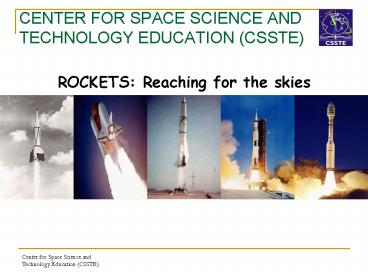CENTER FOR SPACE SCIENCE AND TECHNOLOGY EDUCATION CSSTE - PowerPoint PPT Presentation
1 / 43
Title:
CENTER FOR SPACE SCIENCE AND TECHNOLOGY EDUCATION CSSTE
Description:
The first reported use of true rockets. Chinese fire-arrows were the first simple solid-fuel rockets. ... A rocket is like a balloon containing air under pressure. ... – PowerPoint PPT presentation
Number of Views:199
Avg rating:3.0/5.0
Title: CENTER FOR SPACE SCIENCE AND TECHNOLOGY EDUCATION CSSTE
1
CENTER FOR SPACE SCIENCE AND TECHNOLOGY EDUCATION
(CSSTE)
- ROCKETS Reaching for the skies
2
- EARLY ROCKETRY
3
Around 400BC
- As an entertainment, the Greek, Archytas, used
steam escaping from inside a wooden pigeon to
move the bird along a wire. - This was the first recorded rocket-like flight
4
Around 100BC
- The Greek known as Hero used escaping steam to
create a spinning sphere. - The equipment was called Heros engine
Hero engine
5
13th century
- The first reported use of true rockets.
- Chinese fire-arrows were the first simple
solid-fuel rockets. - The first reported use of rockets as weapons in
Europe.
Chinese fire-arrows
Chinese soldier launching fire arrows
6
- FATHERS OF ROCKETRY
7
- Sir Isaac Newton publishes his three laws of
motion, which explain how rockets work and why
they are able to work in vacuum of outer space
Sir Isaac Newton
8
- Russian schoolteacher Konstantin Tsiolkovsky
realises that liquid fuels would give rockets the
speed and range they would need to escape the
Earths atmosphere and into space. - Suggests space exploration by rocket
Konstantin Tsiolkovsky
9
- Robert Goddard achieved the first successful
flight of a rocket using a liquid fuel on - March 16, 1926
- Developed gyroscope system for flight control and
a payload compartment for scientific instruments
Robert Goddard
10
- Sergei Pavlovich Korolev
- Hermann Oberth
- Werhner von Braun
11
- ROCKET PRINCIPLES
12
- A rocket is like a balloon containing air
under pressure. A small opening at one end allows
the air to escape, and in doing so, provides a
force that pushes the rocket in the opposite
direction.
13
Rocket principles (contd)
- Newtons laws of motion
- First law
- Objects at rest will stay at rest and objects
in motion will stay in motion in a straight line
unless acted upon by an unbalanced force.
14
Rocket principles (contd)
- Newtons laws of motion
- Second law
- Force is equal to mass times acceleration.
15
Rocket principles (contd)
- Newtons laws of motion
- Third law
- For every action there is always an opposite
and equal reaction.
16
- ROCKETS ALBUM
17
March 1942
- The first A4 rocket takes to the skies.
- In its first flight, Von Brauns A4 rocket, known
later as the V2, rose only about 100 metres, then
crashed into the sea, just over a kilometre from
the launch site.
A4 to A9
18
September 1944
- The first V2s are launched against London during
the Second World War
19
1949
- First launch of United States Viking rocket.
Viking launch
20
October 1957
- On 4th October, 1957,
- USSR launched Sputnik 1, the first artificial
satellite to orbit the Earth - It was launched using a V2 rocket
21
January 1958
- Americas first satellite, Explorer 1, is
launched into orbit. - A Jupiter-C rocket, essentially a highly refined
development of the V2, launches Explorer 1.
Explorer 1
Jupiter-C rocket
22
January 1961
- Alan Shepard became the 1st American astronaut to
ride to space on May 5, 1961. - Shepard rode inside a Mercury space capsule on
top of a Redstone rocket
23
1962
- An atlas rocket launches first American into orbit
24
1965
- The first manned Gemini flight.
- A Titan II rocket powers Virgil Grissom and John
Young into space to make three orbits of the
earth.
25
1970
- A Long March rocket launches Mao1, Chinas first
space satellite. - The three-stage rocket is 30m high and 2m in
diameter. Its maximum payload is 300kg.
26
1975
- A Titan III Centaur rocket carried Voyager 1, the
first interplanetary spacecraft to fly by both
Jupiter and Saturn, on Sept 5, 1975.
27
1981
- The Space Shuttle
- 1st flight on April 12, 1981
28
- FUTURE VEHICLES
29
X-34
DC-X
X-33
30
- CSSTE ACTIVITIES
31
(No Transcript)
32
(No Transcript)
33
(No Transcript)
34
(No Transcript)
35
(No Transcript)
36
(No Transcript)
37
(No Transcript)
38
(No Transcript)
39
(No Transcript)
40
(No Transcript)
41
(No Transcript)
42
(No Transcript)
43
- Thank you































![National Institute of Technology - [NITC], Calicut PowerPoint PPT Presentation](https://s3.amazonaws.com/images.powershow.com/9683359.th0.jpg?_=20211114017)